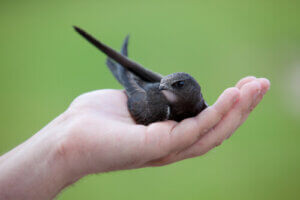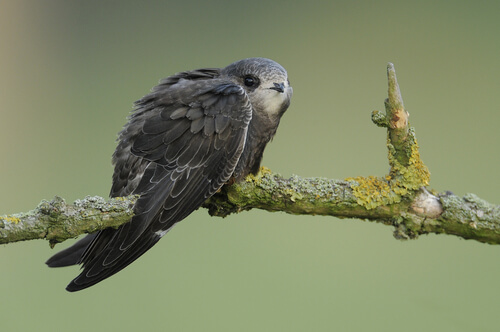Baby Swifts May Need Your Help


Written and verified by the biologist Samuel Sanchez
The common swift (Apus apus) is a bird species that inhabits Eurasia and Africa. Unfortunately, in Europe, it’s common to find baby swifts on the ground during the spring, where they’re at the mercy of predators.
Baby swifts are somewhat different than the rest of baby birds. That’s because this species spends most of the time in the air. As strange as it may seem, these birds reproduce, sleep, and mate while in flight. Their bodies are completely adapted to life in the air, possessing a complex wing morphology and very short legs.
Therefore, when baby swifts fall from the nest, it’s practically a death sentence. That’s because these birds are unable to take flight on their own.
With that in mind, we want to tell you what you can do if you find one of these amazing birds on the ground.
Discovering the swift
Before providing clear instructions, we first want to help you identify this species:
- Swifts are birds with a silhouette in the shape of a crossbow. Also, they have short forked tails and long narrow wings.
- Their feathers are black, and they have a light gray spot on their throats that’s almost imperceptible except from close up.
- Adults measure approximately 6 inches long and have a wingspan of between 16.5 and 19 inches.
- This species remains in flight for 9 consecutive months of the year. They only stop to lay their eggs, incubate them, and raise their young.
Before making the decision to pick up any baby bird you find on the street, you need to make sure it’s actually a swift. Otherwise, you may provide the wrong kind of care. What’s more, you may even pick up a bird that doesn’t need any help at all and, in doing so, separate it from its nest.

Basic care for baby swifts
There are many factors when it comes to caring for any type of bird. However, when it comes to baby birds, it’s important to understand that every second is vitally important. The first two essential steps you need to take are the following:
- Hydrating the animal. The bird may be close to dying due to a lack of water and an excess of solar light. Therefore, hydrating baby swifts is the first thing you need to do. First, dissolve a teaspoon of sugar in water and offer it to the bird. You’ll need to use a syringe to place the liquid in the corner of its mouth. You should never put the liquid in the bird’s beak or you could choke it.
- Place the bird in a box and be sure to keep it away from any windows that receive direct sunlight. The box should be cardboard or plastic, spacious (some 16 inches in diameters). Also, make sure it doesn’t have any bars or projections that could hurt the animal. It’s important to leave the bird alone once you’ve prepared its area. Remember, it’s not uncommon for passerine birds to die from the stress of handling.
What do baby swifts eat?
Feeding baby swifts is complex since they’re exclusive insectivores. Therefore, you’ll need to find an exotic animal shop that sells live food: Crickets, grasshoppers, honeycomb worms, flour worms, etc. You may also be able to find these online.
It’s important to clarify that you shouldn’t go overboard with worms as a means of food. Because worms contain a large amount of fat, grasshoppers and crickets are a better option.
Be sure to give the baby bird one insect every half hour in the early stages, only during the day. Gradually, you’ll work towards feeding the bird every three hours, offering 15 insects per feeding. Additionally, it’s important to give baby swifts vitamin supplements once per day. You can find these supplements in the same stores that sell live food.

And finally, freedom
Never forget that the final goal when it comes to rescuing baby swifts is setting them free. The time will be right when the bird’s feathers have reached maximum development and the bird looks practically like an adult.
So, don’t lose sight of the fact that these are wild animals. Forget about keeping this bird as a pet to play and interact with, and give it back the freedom and autonomy it needs.
The common swift (Apus apus) is a bird species that inhabits Eurasia and Africa. Unfortunately, in Europe, it’s common to find baby swifts on the ground during the spring, where they’re at the mercy of predators.
Baby swifts are somewhat different than the rest of baby birds. That’s because this species spends most of the time in the air. As strange as it may seem, these birds reproduce, sleep, and mate while in flight. Their bodies are completely adapted to life in the air, possessing a complex wing morphology and very short legs.
Therefore, when baby swifts fall from the nest, it’s practically a death sentence. That’s because these birds are unable to take flight on their own.
With that in mind, we want to tell you what you can do if you find one of these amazing birds on the ground.
Discovering the swift
Before providing clear instructions, we first want to help you identify this species:
- Swifts are birds with a silhouette in the shape of a crossbow. Also, they have short forked tails and long narrow wings.
- Their feathers are black, and they have a light gray spot on their throats that’s almost imperceptible except from close up.
- Adults measure approximately 6 inches long and have a wingspan of between 16.5 and 19 inches.
- This species remains in flight for 9 consecutive months of the year. They only stop to lay their eggs, incubate them, and raise their young.
Before making the decision to pick up any baby bird you find on the street, you need to make sure it’s actually a swift. Otherwise, you may provide the wrong kind of care. What’s more, you may even pick up a bird that doesn’t need any help at all and, in doing so, separate it from its nest.

Basic care for baby swifts
There are many factors when it comes to caring for any type of bird. However, when it comes to baby birds, it’s important to understand that every second is vitally important. The first two essential steps you need to take are the following:
- Hydrating the animal. The bird may be close to dying due to a lack of water and an excess of solar light. Therefore, hydrating baby swifts is the first thing you need to do. First, dissolve a teaspoon of sugar in water and offer it to the bird. You’ll need to use a syringe to place the liquid in the corner of its mouth. You should never put the liquid in the bird’s beak or you could choke it.
- Place the bird in a box and be sure to keep it away from any windows that receive direct sunlight. The box should be cardboard or plastic, spacious (some 16 inches in diameters). Also, make sure it doesn’t have any bars or projections that could hurt the animal. It’s important to leave the bird alone once you’ve prepared its area. Remember, it’s not uncommon for passerine birds to die from the stress of handling.
What do baby swifts eat?
Feeding baby swifts is complex since they’re exclusive insectivores. Therefore, you’ll need to find an exotic animal shop that sells live food: Crickets, grasshoppers, honeycomb worms, flour worms, etc. You may also be able to find these online.
It’s important to clarify that you shouldn’t go overboard with worms as a means of food. Because worms contain a large amount of fat, grasshoppers and crickets are a better option.
Be sure to give the baby bird one insect every half hour in the early stages, only during the day. Gradually, you’ll work towards feeding the bird every three hours, offering 15 insects per feeding. Additionally, it’s important to give baby swifts vitamin supplements once per day. You can find these supplements in the same stores that sell live food.

And finally, freedom
Never forget that the final goal when it comes to rescuing baby swifts is setting them free. The time will be right when the bird’s feathers have reached maximum development and the bird looks practically like an adult.
So, don’t lose sight of the fact that these are wild animals. Forget about keeping this bird as a pet to play and interact with, and give it back the freedom and autonomy it needs.
All cited sources were thoroughly reviewed by our team to ensure their quality, reliability, currency, and validity. The bibliography of this article was considered reliable and of academic or scientific accuracy.
- Breves pautas para la cría a mano del vencejo, GREFA. Recogido a día 21 de mayo en https://www.grefa.org/esta-en-tu-mano/la-cria-a-mano-de-vencejos.
- Apus Apus, wikipedia. Recogido a día 21 de mayo en https://es.wikipedia.org/wiki/Apus_apus.
This text is provided for informational purposes only and does not replace consultation with a professional. If in doubt, consult your specialist.








